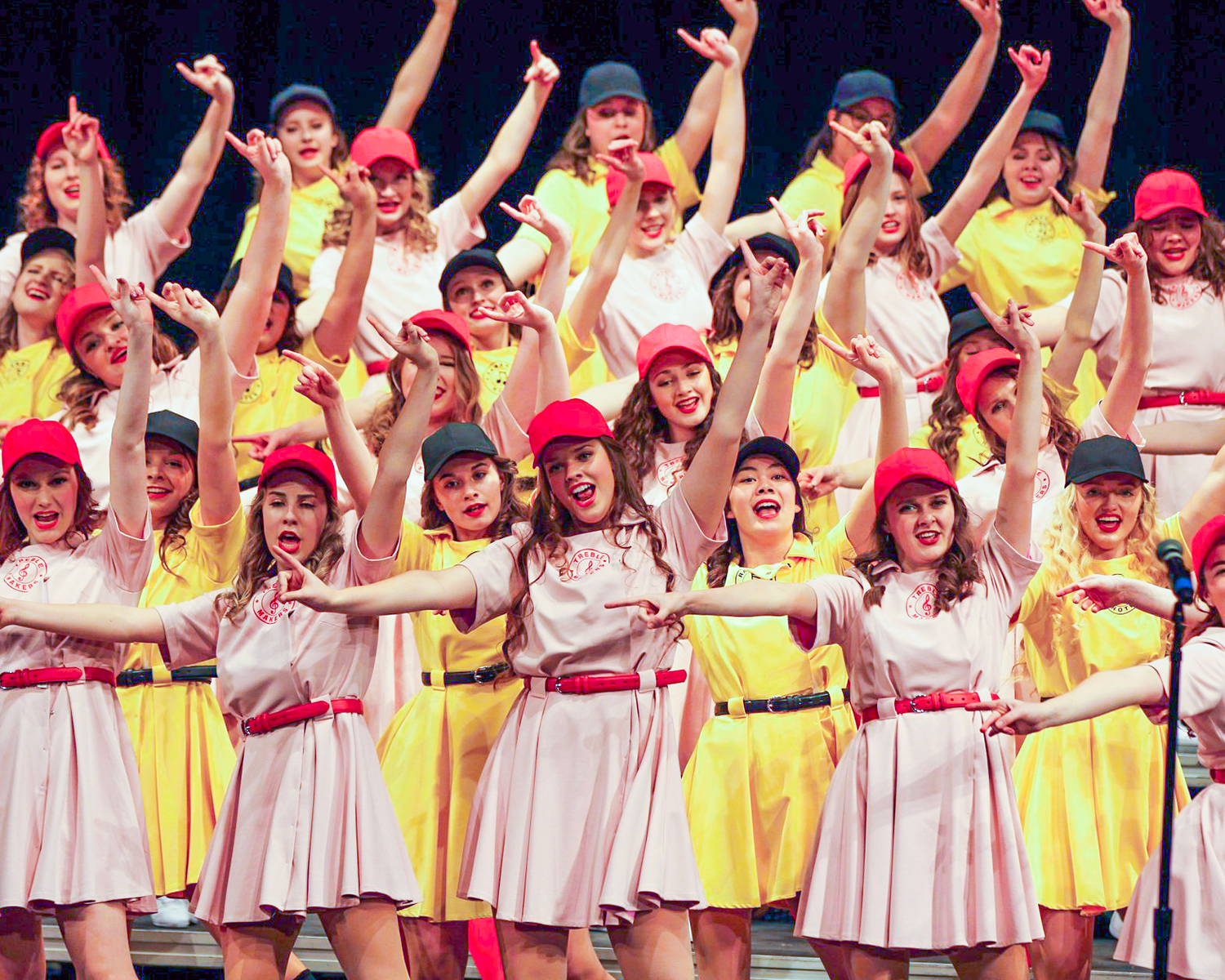
Yes. We have seven curricular choirs that meet during the day at Linn-Mar. Lux, Fortis, Chamber Singers, Linn-Mar Singers, Bella Voce, Concert Chorale, and Cantemus. Our show choirs, Hi-Style, In Step, and 10th Street Edition meet at night. Students are required to be in a curricular choir to be in one of our show choirs, but students are only in one curricular choir typically.
Q: Having ten total choirs offers a lot of opportunity for the Linn-Mar students! You direct 10th Street Edition, the SATB varsity show choir. Who directs the other two?
Sarah Anderson has been my colleague for the last five years at Linn-Mar. She directs In Step, our mixed voice prep show choir. Jack Jorgensen is in his first year teaching here; he directs Hi-Style, our treble show choir.
Q: Last school year for 10th Street Edition, you developed a show set in a pub in County Cork, Ireland, in the 1960s and another show for In Step set in the 1500s during the reign of King Henry VIII. Describe how you and your colleagues decide on the theme of your shows.
The show design portion of our process is quite a long one! Each of the three of us has our own process for how we come to our show decisions, but we always try to create great opportunities for our students to story-tell. We’ve found over the years that if we can build a story that is emotional and has depth, either comedically or dramatically, it’s much easier to motivate our students through that content and experience rather than their eventual competitive standing.
We also really try to perform a variety of show styles and types from year to year. Each summer, I spend a lot of time talking to some close friends and family members after I have an initial story concept. Once we zero in on the story we want to tell, we spend extended time finding the right music to guide the story where we want it to go emotionally. My wife, Lexi Robson, is a HUGE part of this, as well as other friends like Nolan Henkle, Braxton Carr, April James, Hannah Johnson, and Kevin Buglewicz.
Q: The student experience is particularly important. When the students are fully engaged in telling a story through music and movement, the audience can really feel it. What is the process for choosing and arranging music?
The music we choose to fit the story is based on a lot of prerequisites. The first thing we look for is lyrics. In an ideal world, we would always find songs with lyrics that fit the storyline we’ve chosen perfectly. This approach, however, often fails. We also look for the energy and overall vibe of the music. Does the mood of each song fit the emotion we’re trying to convey to an audience? Are each of the styles of the music diverse enough to provide a varying musical experience for students and audiences? Lots of times, if we find a song with the right energy, we can make small necessary lyric changes to make it fit the story. At the end of lots of listening, we also make sure that the music we’ve chosen is generally of quality and something we and the students can bear working on for six months! Our shows are arranged by Dr. Steve Shanley, an associate professor of music at Coe College here in Cedar Rapids. He’s fantastic.
Q: Who is responsible for deciding on costumes, sets, and lighting for the shows?
Each year, Lexi and I travel to Hattiesburg, Mississippi, to meet and design our costumes with Gail McInnis. We’ve been doing custom designs for about six years now, and Gail, Robert, and their crew do an excellent job of working with the things we imagine up. I typically design the sets, but my parent crew and tech guru, Luke Poellet, build it and design the lighting.
Q: I’m sure you are grateful for such solid resources to help with developing and executing your visions for the Linn-Mar show choirs over the years. Other resources are technical crews and live music. Do the Show Choir Crew and Band work with all three groups? Are the Crew and Band also Linn-Mar students?
Our bands are fully made up of Linn-Mar students. We’re lucky enough to have tremendous band and orchestra programs at our school. Their directors—Aaron Nuss, Jen Tiede, Dan Terrell, Josh Reznicow, and Thad Sentman—do fantastic work in their departments and really make my job of putting a band together pretty easy. Each show choir has a band of its own. Our crews are very similar. Each show choir has their own crew of ten to fifteen students. We do often have a parent crew that helps with the building of the sets and some of our stage setup of those sets.
How wonderful that the Linn-Mar student body has so many opportunities to learn and explore differing styles of music, production, and collaboration!
Q: I read in the Linn-Mar Community School District News that “all three Linn-Mar Show Choirs–Hi-Style, In-Step, and 10th Street Edition—took Grand Champion in their respective divisions at the LaCrosse Central Grand River Show Choir Competition in LaCrosse, Wisconsin.” To what do you attribute the success?
We’ve had a lot of competitive success recently, but I really don’t like to measure our success that way. I’m sure a reader would roll their eyes at that comment, but we work to stand by that ideology and honor it with consistency. I’ve always thought that I’d be putting my students in a position to fail if I motivated them with a drive to “win” a competition. We have no control over who will attend, judge, or listen. To base our success on that leaves my student’s experience, the audience’s experience, and our individual growth out of the equation. I’d rather consistently build towards our goal of affecting audiences emotionally, giving students further education in an abundance of musical styles, and offering them a semblance of a dance education.
Another success in 2022 was All-State auditions. According to the District News, “Eighty-eight students auditioned for an opportunity to perform in the 2022 Iowa All-State Music Festival. Of those students, sixty were accepted to either the Iowa All-State Band, Orchestra, or Choir.”
Each of our three musical disciplines at the high school—Band, Choir, and Orchestra—put an emphasis on individual student growth and experiences. This year, many of our students who auditioned for our All-State Music festival were accepted into the state ensemble. I think I can speak for all of our departments when I say that we love the All-State audition process. It takes a lot of individual student work and a high expectation of success from their peers and directors. I always tell my students that, outside of taking private voice lessons, working in quartets and preparing a set of music for an All-State audition is the best way to grow individually in our department.
Q: It sounds like you are creating a caring atmosphere where everyone is encouraged to develop their personal skills as well as support the entire group effort. How does the school as a whole work to ensure every student can achieve success?
I’ve only been at Linn-Mar nine years, but it’s pretty well known to our community members that our district puts an emphasis on academic prowess. We recently moved to a standards-based grading model that allows us to focus even more on individual student achievement and assess our students based on growth and content proficiency. Meeting students where they are and helping them move forward from there can be so positive for everyone involved.
Q: I read in your bio that you are “an avid baseball, basketball, and football fan who is constantly watching and struggling to play at any opportunity.” Can you describe any parallels between those sports, or sports overall, and show choir?
I love that show choir offers our students a physical education in a way like those sports. I also think that all are thoroughly enjoyable to watch. The biggest parallel to me is the opportunity sports and musical ensembles offer to be a part of something so much bigger and more impactful than any student could do alone. In my life, those collaborative experiences were very integral to the person I am today and the values I hold.
Q: Tell us about two or three of your favorite shows during your time at Linn-Mar and why they are so meaningful.
Truly, I’ve enjoyed all our shows for different reasons. Sometimes the final product is so enjoyable to watch, and I love it for that. Sometimes, the memories of the students that made up those ensembles make the show feel differently special and important to me. A few of my all-time favorites are the Nellie Wilhite biopic we did in 2018, the “Yellow Wallpaper” show in 2019, and what my students tell me people call the “potato” show last year. Each of the three had incredible talent displayed on stage but also provided really impactful stories to audiences. The Nellie Wilhite show and the Irish show had happy heartwarming stories that showed a lot of character growth. The “Yellow Wallpaper” had a wildly depressing storyline but was impactful and emotional for very different reasons and offered many morals and lessons. I also feel that in each of those three performance experiences, my students learned something about the world around them that they could take with them into their lives.
High school is definitely an incredible time of personal growth for students. Your approach to show choir connects the emotional side of navigating life with the academic side of vocal and dance technique. The result is amazing experiences for the audience, and most of all for the students. Thank you so much, Trent!











